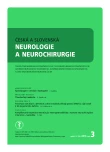Changes in Perfusion Computed Tomography after Conventional Extra‑ Intracranial Bypass Surgery
Authors:
M. Sameš 1; T. Radovnický 1; A. Zolal 1; M. Nováková 2; M. Derner 2; P. Vachata 1; R. Bartoš 1
Authors‘ workplace:
Krajská zdravotní a. s., Masarykova nemocnice v Ústí nad Labem, o. z.
Neurochirurgická klinika Univerzity J. E. Purkyně
1; Krajská zdravotní a. s., Masarykova nemocnice v Ústí nad Labem, o. z.
Radiodiagnostické odd.
2
Published in:
Cesk Slov Neurol N 2010; 73/106(3): 267-273
Category:
Original Paper
Overview
Aim:
The aim of this study was to evaluate the perfusion parameters acquired by perfusion computed tomography (CT) examination of patients after extra - intracranial (EC - IC) bypass surgery. Patients and methods: The set consisted of 14 patients who underwent conventional bypass surgery at our department during the years 2005 – 2008. In all patients, perfusion CT was performed before and after surgery and perfusion magnetic resonance after surgery. The results of the measurements of specific perfusion parameters were compared and the statistical significance of pre ‑ and postoperative differences was evaluated. Results: After the EC - IC bypass surgery, reconstitution of cerebrovascular reserve capacity (CVRC) was achieved, according to the perfusion CT results, in all but one of the patients. A significant difference (p = 0.001) of the change index of cerebral blood flow (at rest/ in stress conditions) in pre‑operative and postoperative examinations was found using the paired T - test. However, there was no significant difference between pre ‑ and postoperative cerebral blood flow values at rest. A significant (p <0.05) difference was found between pre‑operative and postoperative time to peak (TTP) values at rest, and also a borderline significant difference of TTP change index (p = 0.049). Conclusion: A significant improvement in CVRC after EC - IC bypass surgery was confirmed in patients with preoperative deficit, using the perfusion CT examination.
Key words:
perfusion computed tomography – extra-intracranial bypass – cerebrovascular reserve capacity
Sources
1. The EC/ IC Bypass Study Group. Failure of extracranial - intracranial arterial bypass to reduce the risk of ischemic stroke. Results of an international randomized trial. N Engl J Med 1985; 313(19): 1191 – 1200.
2. Schmiedek P, Piepgras A, Leinsinger G, Kirsch CM, Einhüpl K. Improvement of cerebrovascular reserve capacity by EC‑IC arterial bypass surgery in patients with ICA occlusion and hemodynamic cerebral ischemia. J Neurosurg 1994; 81(2): 236 – 244.
3. Garrett MC, Komotar RJ, Starke RM, Merkow MB, Otten ML, Sciacca RR et al. The efficiacy of direct extracranial - intracranial bypass in the treatment of symptomatic hemodynamic failure secondary to athero‑-occlusive disease: a systematic review. Clin Neurol Neurosurg 2009; 111(4): 319 – 326.
4. Mehdorn HM. Cerebral revascularization by EC‑ICvypase – present status. Acta Neurochir 2008; 103 (Suppl): 73 – 77.
5. Wintermark M, Sesay M, Barbier E, Borbély K, Dillon WP, Eastwood JD et al. Comparative overview of brain perfusion imaging techniques. Stroke 2005; 36(9): 83 – 99.
6. Bisdas S, Nemitz O, Berding G, Weissenborn K, Ahl B,Becker H et al. Correlative assessment of cerebral blood flow obtained with perfusion CT and positron emission tomography in symptomatic stenotic carotid disease. Eur Radiol 2006; 16(10): 2220 – 2228.
7. Derdeyn CP, Grubb RL jr, Powers WJ. Indications for cerebral revascularization for patients with atherosclerotic carotid occlusion. Skull Base 2005; 15(1): 7 – 14.
8. Di Piero V, Lenzi GL, Collice M, Triulzi F, Gerundini P,Perani D et al. Long‑term noninvasive single photon emission computed tomography monitoring of perfusional changes after EC‑IC bypass surgery. J Neurol Neurosurg Psychiatry 1987; 50(8): 988 – 996.
9. Wanebo JE, Amin‑Hanjani S, Boyd C, Peery T. Assessing success after cerebral revascularization for ischemia. Skull Base 2005; 15(3): 215 – 227.
10. Derdeyn CP, Videen TO, Yundt KD, Fritsch SM, Car-penter DA, Grubb RL et al. Variability of cerebral bloodvolume and oxygen extraction: stages of cerebral haemodynamic impairment revisited. Brain 2002; 125(3): 595 – 607.
11. Schubert GA, Weinmann C, Seiz M, Gerigk L, Weiss C,Horn P et al. Cerebrovascular insufficiency as the criterion for revascularization procedures in selected patients: a correlation study of xenon contrast - enhanced CT and PWI. Neurosurg Rev 2009; 32(1): 29 – 35.
12. Kajimoto K, Moriwaki H, Yamada N, Hayashida K,Kobayashi J, Miyashita K et al. Cerebral hemodynamic evaluation using perfusion ‑ weighted magnetic resonance imaging: comparison with positron emission tomography values in chronic occlusive carotid disease. Stroke 2003; 34(7): 1662 – 1666.
13. Hoeffner EG, Case I, Jain R, Gujar SK, Shah GV, Deveikis JP et al. Cerebral perfusion CT: technique and clinical applications. Radiology 2004; 231(3): 632 – 644.
14. Furukawa M, Kashiwagi S, Matsunaga N, Suzuki M,Kishimoto K, Shirao S. Evaluation of cerebral perfusion parameters measured by perfusion CT in chronic cerebral ischemia: comparison with xenon CT. J Comput Assist Tomogr 2002; 26(2): 272 – 278.
15. Wintermark M, Thiran JP, Maeder P, Schnyder P, Meuli R. Simultaneous measurement of regional cerebral blood flow by perfusion CT and stable xenon CT: a validation study. Am J Neuroradiol 2001; 22(5): 905 – 914.
16. Gillard JH, Minhas PS, Hayball MP, Bearcroft PW, Antoun NM, Freer CE et al. Assessment of quantitative computed tomographic cerebral perfusion imaging with H2(15)O positron emission tomography. Neurol Res 2000; 22(5): 457 – 464.
17. Sameš M, Bartoš R, Vachata P, Zolal A, Cihlář F, Derner M et al. Hodnocení cerebrovaskulární rezervní kapacity po EC‑IC bypassu pomocí TCD. Cesk Slov Neurol N 2009; 72/ 105(4): 359 – 363.
18. Krahulík D, Vaverka M, Herzig R, Hluštík P, Houdek M. Extra - intrakraniální arteriální mikroanastomóza. Cesk Slov Neurol N 2009; 72/ 105(2): 142 – 146.
Labels
Paediatric neurology Neurosurgery NeurologyArticle was published in
Czech and Slovak Neurology and Neurosurgery

2010 Issue 3
Most read in this issue
- Spondylotic Cervical Myelopathy
- Fractures of the Fifth Lumbar Vertebra
- Standardization of the Czech Version of The Confusion Assessment Method for the Intensive Care Unit (CAM‑ICUcz)
- Complicated Herpetic Necrotising Meningoencephalitis Requiring Neurosurgical Intervention – a Case Report
